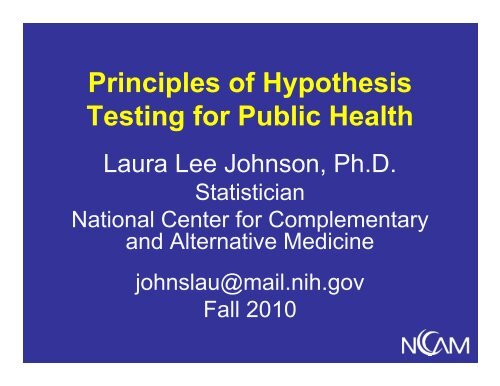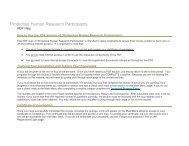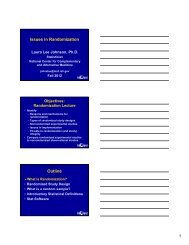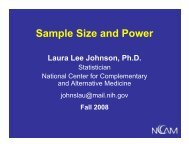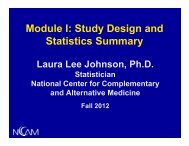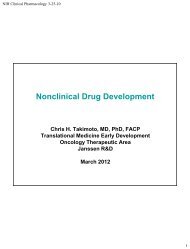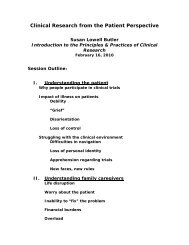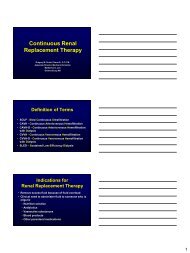Overview of Hypothesis Testing
Overview of Hypothesis Testing
Overview of Hypothesis Testing
Create successful ePaper yourself
Turn your PDF publications into a flip-book with our unique Google optimized e-Paper software.
Principles <strong>of</strong> <strong>Hypothesis</strong><br />
<strong>Testing</strong> for Public Health<br />
Laura Lee Johnson, Ph.D.<br />
Statistician<br />
National Center for Complementary<br />
and Alternative Medicine<br />
johnslau@mail.nih.gov<br />
Fall 2010
Answers to Questions<br />
IU Usually Get Around dNow<br />
• ITT is like generalizing g to real life<br />
• I am not a fan <strong>of</strong> stratification<br />
• Except by clinic/site<br />
• Not everyone agrees with me<br />
• OK to adjust for (some) variables<br />
• Baseline covariates<br />
• Cannot stratify a continuous variable<br />
• At least rarely can you do it well<br />
• Some variables are not ok, or you just<br />
upgraded to a fancy model!
Objectives<br />
• Formulate questions for statisticians<br />
and epidemiologists using<br />
• P-value<br />
• Power<br />
• Type I and Type II errors<br />
• Identity a few commonly used<br />
statistical tests for comparing two<br />
groups
Outline<br />
‣Estimation and Hypotheses<br />
• How to Test Hypotheses<br />
• Confidence Intervals<br />
• Regression<br />
• Error<br />
• Diagnostic <strong>Testing</strong><br />
• Misconceptions<br />
• Appendix
Estimation and Hypotheses<br />
‣Inference<br />
‣How we use <strong>Hypothesis</strong> <strong>Testing</strong><br />
• Estimation<br />
• Distributions<br />
• <strong>Hypothesis</strong> testing<br />
• Sides and Tails
Statistical Inference<br />
• Inferences about a population are<br />
made on the basis <strong>of</strong> results<br />
obtained from a sample drawn<br />
from that population<br />
• Want to talk about the larger<br />
population from which the subjects<br />
are drawn, not the particular<br />
subjects!
You Use <strong>Hypothesis</strong> <strong>Testing</strong><br />
• Designing your study<br />
• Reviewing the design <strong>of</strong> other studies<br />
• Grant or application review (e.g. NIH<br />
study section, IRB)<br />
• Interpreting your study results<br />
• Interpreting other’s study results<br />
• Reviewing i a manuscript or journal<br />
• Interpreting the news
I Use <strong>Hypothesis</strong> <strong>Testing</strong><br />
• Do all you do<br />
• Analyze the data to find the results<br />
• Program formulas not presented<br />
here in detail<br />
• You can analyze the data, too, but<br />
be careful
Analysis Follows Design<br />
Questions → Hypotheses →<br />
Experimental Design → Samples →<br />
Data → Analyses →Conclusions
What Do We Test<br />
• Effect or Difference we are interested in<br />
• Difference in Means or Proportions<br />
• Odds Ratio (OR)<br />
• Relative Risk (RR)<br />
• Correlation Coefficient<br />
• Clinically i ll important t difference<br />
• Smallest difference considered<br />
biologically or clinically relevant<br />
• Medicine: usually 2 group comparison<br />
<strong>of</strong> population means
Estimation and Hypotheses<br />
Inference<br />
How we use <strong>Hypothesis</strong> <strong>Testing</strong><br />
‣Estimation<br />
• Distributions<br />
• <strong>Hypothesis</strong> testing<br />
• Sides and Tails
Estimation: From the Sample<br />
• Point estimation<br />
• Mean<br />
• Median<br />
• Change in mean/median<br />
• Interval estimation<br />
• Variation (e.g. range, σ 2 , σ, σ/√n)<br />
• 95% Confidence interval
Pictures, Not Numbers<br />
• Scatter plots<br />
• Bar plots (use a table)<br />
• Histograms<br />
• Box plots<br />
• Not Estimation<br />
• See the data and check assumptions
Graphs and Tables<br />
• A picture is worth a thousand t-tests<br />
• Vertical (Y) axis can be misleading
Like the Washington Post<br />
Weather, Though<br />
h
Estimation and Hypotheses<br />
Inference<br />
How we use <strong>Hypothesis</strong> <strong>Testing</strong><br />
Estimation<br />
‣Distributions<br />
• <strong>Hypothesis</strong> testing<br />
• Sides and Tails
Distributions<br />
• Parametric tests are based on<br />
distributions<br />
• Normal Distribution (standard<br />
normal, bell curve, Z distribution)<br />
• Non-parametric tests still have<br />
assumptions, but not based on<br />
distributions
2 <strong>of</strong> the Continuous Distributions<br />
• Normal/Gaussian distribution: N( μ, σ 2 )<br />
• μ = mean, σ 2 = variance<br />
• Z or standard normal = N(0,1)<br />
• t distribution: t ω<br />
• ω = degrees <strong>of</strong> freedom (df)<br />
•Usually a function <strong>of</strong> sample size<br />
• Mean = X (sample mean)<br />
• Variance = s 2 (sample variance)
Binary Distribution<br />
• Binomial distribution: B (n, p)<br />
• Sample size = n<br />
• Proportion ‘yes’ = p<br />
• Mean = np<br />
• Variance = np(1-p)<br />
• Can do exact or use Normal
Many More Distributions<br />
• Not going to cover<br />
• Poisson<br />
• Log normal<br />
• Gamma<br />
• Beta<br />
• Weibull<br />
• Many more
Estimation and Hypotheses<br />
Inference<br />
How we use <strong>Hypothesis</strong> <strong>Testing</strong><br />
Estimation<br />
Distributions<br />
‣<strong>Hypothesis</strong> <strong>Testing</strong><br />
‣Sides and Tails
<strong>Hypothesis</strong> <strong>Testing</strong><br />
• Null hypothesis (H 0 )<br />
• Alternative hypothesis (H 1 or H a )
Null <strong>Hypothesis</strong><br />
• For superiority studies we think for example<br />
• Average systolic blood pressure (SBP) on<br />
Drug A is different than average SBP on<br />
Drug B<br />
• Null <strong>of</strong> that? Usually that there is no effect<br />
• Mean = 0<br />
• OR = 1<br />
• RR = 1<br />
• Correlation Coefficient = 0<br />
• Sometimes compare to a fixed value so Null<br />
• Mean = 120<br />
• If an equivalence trial, look at NEJM paper or<br />
other specific resources
Alternative <strong>Hypothesis</strong><br />
• Contradicts the null<br />
• There is an effect<br />
• What you want to prove<br />
• If equivalence trial, special way to<br />
do this
Example Hypotheses<br />
• H 0 : μ 1 = μ 2<br />
• H A : μ 1 ≠μ 2<br />
• Two-sided test<br />
• H A : μ 1 > μ 2<br />
• One-sided test
1 vs. 2 Sided Tests<br />
• Two-sided test<br />
• No a priori reason 1 group should<br />
have stronger effect<br />
• Used for most tests<br />
One sided test<br />
• One-sided test<br />
• Specific interest in only one direction<br />
• Not scientifically relevant/interesting<br />
if reverse situation true
Use a 2-Sided Test<br />
• Almost always<br />
• If you use a one-sided test<br />
• Explain yourself<br />
• Penalize yourself on the alpha<br />
•0.05 2-sided test becomes a<br />
0.025 1-sided test
Never “Accept” Anything<br />
• Reject the null hypothesis<br />
• Fail to reject the null hypothesis<br />
• Failing to reject the null hypothesis does<br />
NOT mean the null (H 0 ) is true<br />
• Failing to reject the null means<br />
• Not enough evidence in your sample to<br />
reject the null hypothesis<br />
• In one sample saw what you saw
Outline<br />
Estimation and Hypotheses<br />
‣How to Test Hypotheses<br />
• Confidence Intervals<br />
• Regression<br />
• Error<br />
• Diagnostic <strong>Testing</strong><br />
• Misconceptions
Experiment<br />
‣Develop hypotheses<br />
‣Collect sample/Conduct<br />
experiment<br />
• Calculate test statistic<br />
• Compare test statistic with what is<br />
expected when H 0 is true<br />
p 0
Information at Hand<br />
• 1 or 2 sample test?<br />
• Outcome variable<br />
• Binary, Categorical, Ordered,<br />
Continuous, Survival<br />
• Population<br />
• Numbers (e.g. mean, standard<br />
deviation)
Example:<br />
Hypertension/Cholesterol<br />
l<br />
• Mean cholesterol hypertensive men<br />
• Mean cholesterol in male general<br />
(normotensive) population (20-74<br />
years old)<br />
• In the 20-74 year old male<br />
population the mean serum<br />
cholesterol is 211 mg/ml with a<br />
standard deviation <strong>of</strong> 46 mg/ml
One Sample:<br />
Cholesterol l Sample Data<br />
• Have data on 25 hypertensive men<br />
• Mean serum cholesterol level is<br />
220mg/ml ( X = 220 mg/ml)<br />
• Point estimate <strong>of</strong> the mean<br />
• Sample standard deviation: s =<br />
38.6 mg/ml<br />
• Point estimate <strong>of</strong> the variance = s 2
Compare Sample to Population<br />
• Is 25 enough?<br />
• Next lecture we will discuss<br />
• What difference in cholesterol l is<br />
clinically or biologically<br />
meaningful?<br />
• Have an available sample and want<br />
to know if hypertensives are<br />
different than general population<br />
p
Situation<br />
• May be you are reading another<br />
person’s work<br />
• May be already collected data<br />
• If you were designing up front you<br />
would calculate l the sample size<br />
• But for now, we have 25 people<br />
p
Cholesterol Hypotheses<br />
• H 0 : μ 1 = μ 2<br />
• H 0 : μ = 211 mg/ml<br />
• μ = POPULATION mean serum<br />
cholesterol for male hypertensives<br />
• Mean cholesterol for hypertensive<br />
men = mean for general male<br />
population<br />
• H A : μ 1 ≠ μ 2<br />
• H A : μ ≠ 211 mg/ml
Cholesterol Sample Data<br />
• Population information (general)<br />
• μ = 211 mg/ml<br />
• σ = 46 mg/ml (σ(<br />
2 = 2116)<br />
• Sample information (hypertensives)<br />
X<br />
• = 220 mg/ml<br />
• s=386mg/ml(s 38.6 2 = 1489.96)<br />
96)<br />
• N = 25
Experiment<br />
Develop hypotheses<br />
Collect sample/Conduct experiment<br />
‣Calculate test statistic<br />
• Compare test statistic with what is<br />
expected when H 0 is true
Test Statistic<br />
• Basic test statistic for a mean<br />
test statistic =<br />
point estimate <strong>of</strong><br />
σ<br />
μ - target value <strong>of</strong><br />
point estimate <strong>of</strong> μ<br />
μ<br />
• σ = standard deviation (sometimes use σ/√n)<br />
• For 2-sided test: Reject H 0 when the test<br />
statistic is in the upper or lower 100*α/2% <strong>of</strong><br />
the reference distribution<br />
• What is α?
Vocabulary<br />
• Types <strong>of</strong> errors<br />
• Type I (α) (false positives)<br />
• Type II (β) (false negatives)<br />
• Related words<br />
• Significance Level: α level<br />
• Power: 1- β
Unknown Truth and the Data<br />
Data<br />
Truth<br />
H 0 Correct<br />
H A Correct<br />
Decide H 0<br />
1- α<br />
β<br />
“fail to reject True Negative False Negative<br />
H 0 ”<br />
H 0<br />
Decide H A<br />
“reject H 0 ”<br />
α<br />
False Positive 1- β<br />
True Positive<br />
α = significance level<br />
1- β = power
Type I Error<br />
• α = P( reject H 0 |H 0 true)<br />
• Probability reject the null hypothesis<br />
given the null is true<br />
• False positive<br />
• Probability reject that hypertensives’<br />
µ=211mg/ml when in truth the mean<br />
cholesterol for hypertensives is 211
Type II Error (or, 1- Power)<br />
• β = P( do not reject H 0 |H 1 true )<br />
• False Negative<br />
• Probability bilit we NOT reject that t male<br />
hypertensives’ cholesterol is that<br />
<strong>of</strong> fthe general population when in<br />
truth the mean cholesterol for<br />
hypertensives is different than the<br />
general male population
Power<br />
• Power = 1-β = P( reject H 0 |H 1 true )<br />
• Everyone wants high power, and<br />
therefore low Type II error
Cholesterol Sample Data<br />
• N = 25<br />
• X = 220 mg/ml<br />
• μ = 211 mg/ml<br />
• s = 38.6 mg/ml (s 2 = 1489.96)<br />
• σ = 46 mg/ml (σ 2 = 2116)<br />
• α =005<br />
0.05<br />
• Power? Next lecture!
Z Test Statistic and N(0,1)<br />
• Want to test continuous outcome<br />
• Known variance<br />
• Under H 0<br />
X −<br />
μ 0<br />
~ N(0,1)<br />
σ / n<br />
• Therefore,<br />
X − μ0<br />
Reject H<br />
0<br />
if > 1.96 (gives a 2-sided α =0.05 test)<br />
σ<br />
/ n<br />
σ<br />
Reject H 0<br />
if X > μ<br />
0<br />
+ 1.96 or X < μ<br />
0<br />
−1.96<br />
n<br />
σ<br />
n
Experiment<br />
Develop hypotheses<br />
Collect sample/Conduct experiment<br />
Calculate test statistic<br />
‣Compare test statistic with what is<br />
expected when H 0 is true<br />
• Reference distribution<br />
• Assumptions about distribution ib ti <strong>of</strong><br />
outcome variable
Z or Standard Normal<br />
Distributionib<br />
i
Z or Standard Normal<br />
Distributionib<br />
i
Z or Standard Normal<br />
Distributionib<br />
i
How to test?<br />
‣Rejection interval<br />
j<br />
• Like a confidence interval but<br />
centered on the null mean<br />
• Z test or Critical Value<br />
• N(0,1) distribution and alpha<br />
• t test or Critical Value<br />
• t distribution and alpha<br />
• P-value<br />
• Confidence interval
General Formula (1-α)%<br />
Rejection Region for Mean Point<br />
Estimate<br />
⎛<br />
⎜<br />
⎝<br />
μ<br />
Z σ<br />
Z<br />
−<br />
1 −α/2 , μ +<br />
1 −α/2<br />
n n<br />
σ<br />
⎞<br />
⎟<br />
⎠<br />
• Note that +Z (α/2) = - Z (1-α/2)<br />
• 90% CI : Z = 1.645<br />
• 95% CI : Z = 1.96<br />
• 99% CI : Z = 2.58
Cholesterol Rejection Interval<br />
Using H 0 Population Information<br />
Reject H o if<br />
220 is outside<br />
N(211, 46 2 ) <strong>of</strong> (193,229)<br />
193 211 229<br />
Normal Distribution
Cholesterol Rejection Interval<br />
Using H 0 Sample Information<br />
t (df=24, 211, 38.6 2 )<br />
Reject H o if<br />
220 is outside<br />
<strong>of</strong> (195,227)<br />
195 211 227<br />
t Distribution (df = 24)
Side Note on t vs. Z<br />
• If s = σ then the t value will be<br />
larger than the Z value<br />
• BUT, here our sample standard<br />
deviation (38.6) was quite a bit<br />
smaller than the population sd (46)<br />
• HERE intervals using t look<br />
smaller than Z intervals BUT<br />
• Because <strong>of</strong> sd, not distribution
How to test?<br />
Rejection interval<br />
j<br />
• Like a confidence interval but<br />
centered on the null mean<br />
‣Z test or Critical Value<br />
• N(0,1) distribution and alpha<br />
‣t test or Critical Value<br />
• t distribution and alpha<br />
• P-value<br />
• Confidence interval
Z-test: Do Not Reject H 0<br />
Z<br />
X − μ<br />
220 −<br />
211<br />
=<br />
0<br />
= = 0.98 < 1.96<br />
σ / n 46/ 25
Z or Standard Normal<br />
Distributionib<br />
i
Determining Statistical<br />
Significance: Critical Value Method<br />
• Compute the test statistic Z (0.98)<br />
• Compare to the critical value<br />
• Standard Normal value at α-level (1.96)<br />
• If |test statistic| > critical value<br />
• Reject H 0<br />
• Results are statistically significant<br />
• If |test statistic| < critical value<br />
• Do not reject H 0<br />
• Results are not statistically significant
T-Test Test Statistic<br />
• Want to test continuous outcome<br />
• Unknown variance (s, not σ)<br />
• Under H X − μ<br />
0 0<br />
s<br />
/<br />
n<br />
~<br />
t<br />
( n−1)<br />
• Critical values: statistics books or<br />
computer<br />
• t-distribution approximately normal for<br />
degrees <strong>of</strong> freedom (df) >30
Cholesterol: t-statistic<br />
X − μ 220 − 211<br />
0<br />
• Using data<br />
T<br />
= = =<br />
s/ n 38.6 / 25<br />
117 1.17<br />
• For α = 005 0.05, two-sided d test t from t(24)<br />
distribution the critical value = 2.064<br />
• | T | = 1.17 < 2.064<br />
• The difference is not statistically<br />
significant at the α = 0.05 level<br />
• Fail to reject H 0
Almost all ‘Critical Value’ Tests:<br />
• Paired tests<br />
• 2-sample tests<br />
• Continuous data<br />
• Binary data<br />
Exact Same Idea<br />
• See appendix at end <strong>of</strong> slides
How to test?<br />
Rejection interval<br />
j<br />
• Like a confidence interval but<br />
centered on the null mean<br />
Z test or Critical Value<br />
• N(0,1) distribution and alpha<br />
t test or Critical Value<br />
• t distribution and alpha<br />
‣P-value<br />
• Confidence interval
P-value<br />
• Smallest α the observed sample would<br />
reject H 0<br />
• Given H 0 is true, probability <strong>of</strong><br />
obtaining a result as extreme or more<br />
extreme than the actual sample<br />
• MUST be based on a model<br />
• Normal, t, binomial, etc.
Cholesterol Example<br />
• P-value for two sided test<br />
• X = 220 mg/ml, σ = 46 mg/ml<br />
• n = 25<br />
• H 0 : μ = 211 mg/ml<br />
• H A : μ ≠ 211 mg/ml<br />
2* PX> [ 220] = 0.33
Determining Statistical<br />
Significance: ifi P-Value Method<br />
• Compute the exact p-value (0.33)<br />
• Compare to the predetermined α-level<br />
(0.05)<br />
• If p-value < predetermined α-level<br />
• Reject H 0<br />
• Results are statistically significant<br />
• If p-value > predetermined α-level<br />
• Do not reject H 0<br />
• Results are not statistically significant
P-value Interpretation Reminders<br />
• Measure <strong>of</strong> the strength <strong>of</strong><br />
evidence in the data that the null is<br />
not ttrue<br />
• A random variable whose value<br />
lies between 0 and 1<br />
• NOT the probability that the null<br />
hypothesis is true.
How to test?<br />
Rejection interval<br />
j<br />
• Like a confidence interval but<br />
centered on the null mean<br />
Z test or Critical Value<br />
• N(0,1) distribution and alpha<br />
t test or Critical Value<br />
• t distribution and alpha<br />
P-value<br />
• Confidence interval
Outline<br />
Estimation and Hypotheses<br />
How to Test Hypotheses<br />
‣Confidence Intervals<br />
• Regression<br />
• Error<br />
• Diagnostic <strong>Testing</strong><br />
• Misconceptions
General Formula (1-α)% CI for μ<br />
⎛<br />
⎜<br />
⎝<br />
X<br />
Z σ<br />
Z<br />
−<br />
1 −α/2 , X +<br />
1 −α/2<br />
n n<br />
σ<br />
⎞<br />
⎟<br />
⎠<br />
• Construct an interval around the point<br />
estimate<br />
• Look to see if the population/null mean<br />
is inside
Cholesterol Confidence Interval<br />
Using Population Variance ( Z )<br />
N(220, 46 2 )<br />
196 202 211 220 229 238 244
CI for the Mean, Unknown<br />
Variance<br />
• Pretty common<br />
• Uses the t distribution<br />
• Degrees <strong>of</strong> freedom<br />
⎛ tn− 1,1 −α/ 2s tn− 1,1 −α/ 2s⎞<br />
⎜<br />
X − ,<br />
X<br />
+<br />
⎟<br />
⎝ n<br />
n ⎠<br />
⎛ 2.064*38.6 2.064*38.6<br />
= ⎜<br />
220 − , 220<br />
+<br />
⎝ 25 25<br />
= (204.06, 235.93)<br />
⎞<br />
⎟<br />
⎠
Cholesterol Confidence Interval<br />
Using Sample Data ( t )<br />
t (df=24, 220, 38.6 2 )<br />
198 204 212 220 228 236 242
But I Have All Zeros!<br />
Calculate l 95% upper bound<br />
• Known # <strong>of</strong> trials without an event (2.11<br />
van Belle 2002, Louis 1981)<br />
• Given no observed events in n trials,<br />
95% upper bound on rate <strong>of</strong> occurrence<br />
is 3 / (n + 1)<br />
• No fatal outcomes in 20 operations<br />
• 95% upper bound on rate <strong>of</strong><br />
occurrence = 3/(20+1)= 0.143, so<br />
the rate <strong>of</strong> occurrence <strong>of</strong> fatalities<br />
could be as high as 14.3%
<strong>Hypothesis</strong> <strong>Testing</strong><br />
and dConfidence Intervals<br />
• <strong>Hypothesis</strong> testing focuses on<br />
where the sample mean is located<br />
• Confidence intervals focus on<br />
plausible values for the population<br />
p<br />
mean
CI Interpretation<br />
• Cannot determine if a particular interval<br />
does/does not contain true mean<br />
• Can say in the long run<br />
• Take many samples<br />
• Same sample size<br />
• From the same population<br />
• 95% <strong>of</strong> similarly constructed confidence<br />
intervals will contain true mean<br />
• Think about meta analyses
Interpret a 95% Confidence<br />
Interval (CI) for the population<br />
mean, μ<br />
• “If we were to find many such<br />
intervals, each from a different<br />
random sample but in exactly the<br />
same fashion, then, in the long run,<br />
about 95% <strong>of</strong> our intervals would<br />
include the population mean, μ,<br />
and 5% would not.”
Do NOT interpret a 95% CI…<br />
• “There is a 95% probability that the true<br />
mean lies between the two confidence<br />
values we obtained from a particular<br />
sample”<br />
• “We can say that we are 95% confident<br />
that the true mean does lie between<br />
these two values.”<br />
• Overlapping CIs do NOT imply nonsignificance
Take Home: <strong>Hypothesis</strong> <strong>Testing</strong><br />
• Many ways to test<br />
• Rejection interval<br />
• Z test, t test, or Critical Value<br />
• P-value<br />
• Confidence interval<br />
• For this, all ways will agree<br />
• If not: math wrong, rounding errors<br />
• Make sure interpret correctly
Take Home <strong>Hypothesis</strong> <strong>Testing</strong><br />
• How to turn questions into hypotheses<br />
• Failing to reject the null hypothesis<br />
DOES NOT mean that the null is true<br />
• Every test has assumptions<br />
• A statistician can check all the<br />
assumptions<br />
• If the data does not meet the assumptions<br />
there are non-parametric versions <strong>of</strong> tests<br />
(see text)
Take Home: CI<br />
• Meaning/interpretation <strong>of</strong> the CI<br />
• How to compute a CI for the true<br />
mean when variance is known<br />
(normal model)<br />
• How to compute a CI for the true<br />
mean when the variance is NOT<br />
known (t distribution)
Take Home: Vocabulary<br />
• Null <strong>Hypothesis</strong>: H 0<br />
• Alternative <strong>Hypothesis</strong>: H 1 or H a or H A<br />
• Significance Level: α level<br />
• Acceptance/Rejection Region<br />
• Statistically ti ti Significant<br />
ifi • Test Statistic<br />
• Critical Value<br />
• P-value, Confidence Interval
Outline<br />
Estimation and Hypotheses<br />
How to Test Hypotheses<br />
Confidence Intervals<br />
‣Regressiong<br />
• Error<br />
• Diagnostic <strong>Testing</strong><br />
• Misconceptions
Regression<br />
• Continuous outcome<br />
• Linear<br />
• Binary outcome<br />
• Logistic<br />
• Many other types
Linear regression<br />
• Model for simple linear regression<br />
• Y i = β 0 + β 1 x 1i + ε i<br />
• β 0 = intercept<br />
• β 1 = slope<br />
• Assumptions<br />
• Observations are independent<br />
d • Normally distributed with constant<br />
variance<br />
• <strong>Hypothesis</strong> testing<br />
• H 0 : β 1 = 0 vs. H A : β 1 ≠ 0
In Order <strong>of</strong> Importance<br />
1. Independence<br />
2. Equal variance<br />
3. Normality<br />
(for ANOVA and linear regression)
More Than One Covariate<br />
• Y i = β 0 + β 1 x 1i + β 2 x 2i + β 3 x 3i + ε i<br />
• SBP =<br />
β 0 + β 1 Drug + β 2 Male + β 3 Age<br />
• β 1<br />
• Association between Drug and SBP<br />
• Average difference in SBP between<br />
the Drug and Control groups, given<br />
sex and age
<strong>Testing</strong>?<br />
• Each β has a p-value associated with it<br />
• Each model will have an F-test<br />
• Other methods to determine fit<br />
• Residuals<br />
• See a statistician and/or take a<br />
See a statistician and/or take a<br />
biostatistics class. Or 3.
Repeated Measures<br />
(3 or more time points)<br />
• Do NOT use repeated measures<br />
AN(C)OVA<br />
• Assumptions quite stringent<br />
• Talk to a statistician<br />
• Mixed model<br />
• Generalized estimating equations<br />
• Other
An Aside: Correlation<br />
• Range: -1 to1<br />
• Test is correlation is ≠ 0<br />
• With N=1000, easy to have highly<br />
hl<br />
significant (p
Do Not Use Correlation.<br />
Use Regression<br />
• Some fields: Correlation still popular<br />
• Partial regression coefficients<br />
• High correlation is > 0.8 08(in absolute<br />
value). Maybe 0.7<br />
• Never believe a p-value from a<br />
correlation test<br />
• Regression coefficients are more<br />
meaningful
Analysis Follows Design<br />
Questions → Hypotheses →<br />
Experimental Design → Samples →<br />
Data → Analyses →Conclusions
Outline<br />
Estimation and Hypotheses<br />
How to Test Hypotheses<br />
Confidence Intervals<br />
Regressiong<br />
‣Error<br />
• Diagnostic <strong>Testing</strong><br />
• Misconceptions
Is α or β more important ?<br />
• Depends on the question<br />
• Most will say protect against Type I<br />
error<br />
• Multiple comparisons<br />
• Need to think about individual and<br />
population health implications and<br />
costs
Omics<br />
• False negative (Type II error)<br />
• Miss what could be important<br />
• Are these samples going to be<br />
looked at again?<br />
• False positive (Type I error)<br />
• Waste resources following dead<br />
ends
HIV Screening<br />
• False positive<br />
• Needless worry<br />
• Stigma<br />
• False negative<br />
• Thinks everything is ok<br />
• Continues to spread disease<br />
• For cholesterol example?
What do you need to think<br />
about?<br />
• Is it worse to treat those who truly<br />
are not ill or to not treat those who<br />
are ill?<br />
• That answer will help pguide you as<br />
to what amount <strong>of</strong> error you are<br />
willing to tolerate in your trial<br />
design
Outline<br />
Estimation and Hypotheses<br />
How to Test Hypotheses<br />
Confidence Intervals<br />
Regressiong<br />
Error<br />
‣Diagnostic <strong>Testing</strong><br />
• Misconceptions
Little Diagnostic <strong>Testing</strong><br />
Lingo<br />
• False Positive/False Negative (α, β)<br />
• Positive Predictive Value (PPV)<br />
• Probability diseased given POSITIVE<br />
test result<br />
• Negative Predictive Value (NPV)<br />
• Probability NOT diseased given<br />
NEGATIVE test result<br />
• Predictive values depend on disease<br />
prevalence
Sensitivity, Specificity<br />
• Sensitivity: how good is a test at<br />
correctly IDing people who have<br />
disease<br />
• Can be 100% if you say everyone<br />
is ill (all have positive result)<br />
• Useless test with bad Specificity<br />
• Specificity: how good is the test at<br />
correctly IDing people p who are well
Example: Western vs. ELISA<br />
• 1 million people<br />
• ELISA Sensitivity = 99.9%<br />
• ELISA Specificity = 99.9% 9%<br />
• 1% prevalence <strong>of</strong> infection<br />
• 10,000000 positive by Western (gold<br />
standard)<br />
• 9990 true positives (TP) by ELISA<br />
• 10 false negatives (FN) by ELISA
1% Prevalence<br />
• 990,000000 not infected<br />
• 989,010 True Negatives (TN)<br />
• 990 False Positives (FP)<br />
• Without confirmatory test<br />
• Tell 990 or ~0.1% <strong>of</strong> the population<br />
they are infected when in reality they<br />
are not<br />
• PPV = 91%, NPV = 99.999% 999%
1% Prevalence<br />
• 10980 total test positive by ELISA<br />
• 9990 true positive<br />
• 990 false positive<br />
• 9990/10980 = probability diseased GIVEN<br />
positive by ELISA = PPV = 0.91 = 91%<br />
• 989,020 total test negatives by ELISA<br />
• 989,010 true negatives<br />
• 10 false negatives<br />
• 989010/989020 = NPV = 99.999%
0.1% Prevalence<br />
• 1,000 infected – ELISA picks up 999<br />
• 1 FN<br />
• 999,000 not infected<br />
• 989,001 True Negatives (TN)<br />
• 999 False Positives (FP)<br />
• Positive predictive value = 50%<br />
• Negative predictive value = 99.999%
10% Prevalence<br />
• 99% PPV<br />
• 99.99% NPV
Prevalence Matters<br />
(Population You Sample to Estimate<br />
Prevalence, too)<br />
• Numbers look “good” with high<br />
prevalence<br />
• <strong>Testing</strong> at STD clinic in high risk<br />
populations<br />
• Low prevalence means even very high<br />
sensitivity and specificity will result in<br />
middling PPV<br />
• Calculate PPV and NPV for 0.01% 01%<br />
prevalence found in female blood<br />
donors
Prevalence Matters<br />
• PPV and NPV tend to come from<br />
good cohort data<br />
• Can estimate PPV/NPV from case<br />
control studies but the formulas<br />
are hard and you need to be<br />
REALLY sure about the prevalence<br />
• Triple sure
High OR<br />
Does Not a Good Test Make<br />
• Diagnostic tests need separation<br />
• ROC curves<br />
• Not logistic regression with high<br />
OR<br />
• Strong association between 2<br />
variables does not mean good<br />
prediction <strong>of</strong> separation
What do you need to think<br />
about?<br />
• How good does the test need to be?<br />
• 96% sensitivity and 10% specificity?<br />
• 66% AUC? (What is that?)<br />
t?)<br />
• Guide you as to what amount <strong>of</strong><br />
differentiation, levels <strong>of</strong> sensitivity,<br />
specificity, PPV and NPV you are<br />
willing to tolerate in your trial design
Outline<br />
Estimation and Hypotheses<br />
How to Test Hypotheses<br />
Confidence Intervals<br />
Regression<br />
Error<br />
Diagnostic <strong>Testing</strong><br />
‣Misconceptions<br />
‣Appendix
Avoid Common Mistakes:<br />
<strong>Hypothesis</strong> <strong>Testing</strong><br />
• Mistake: Have paired data and do not<br />
do a paired test OR do not have paired<br />
data and do a paired test<br />
• If you have paired data, use a paired<br />
test<br />
• If you don’t then you can lose power<br />
• If you do NOT have paired data, do NOT<br />
use a paired test<br />
• You can have the wrong inference
Avoid Common Mistakes:<br />
<strong>Hypothesis</strong> <strong>Testing</strong><br />
• Mistake: assume independent measurements<br />
• Tests have assumptions <strong>of</strong> independence<br />
• Taking multiple samples per subject ?<br />
Statistician MUST know<br />
• Different statistical analyses MUST be<br />
used and they can be difficult!<br />
• Mistake: ignore distribution <strong>of</strong> observations<br />
• Histogram <strong>of</strong> the observations<br />
• Highly skewed data - t test and even non-<br />
parametric tests can have incorrect results
Avoid Common Mistakes:<br />
<strong>Hypothesis</strong> <strong>Testing</strong><br />
• Mistake: Assume equal variances<br />
(and the variances are not equal)<br />
• Did not show variance test<br />
• Not that good <strong>of</strong> a test<br />
• ALWAYS graph your data first to<br />
assess symmetry y and variance<br />
• Mistake: Not talking to a<br />
statistician
Estimates and P-Values<br />
• Study 1: 25±9<br />
• Stat sig at the 1% level<br />
• Study 2: 10±9<br />
• Not statistically significant (ns)<br />
• 25 vs. 10 wow a big difference<br />
between these studies!<br />
• Um, no. 15±12.7
Comparing A to B<br />
• Appropriate<br />
• Statistical properties <strong>of</strong> A-B<br />
• Statistical ti ti properties <strong>of</strong> A/B<br />
• NOT Appropriate<br />
p<br />
• Statistical properties <strong>of</strong> A<br />
• Statistical properties <strong>of</strong> B<br />
• Look they are different!
Not a big difference? 15?!?<br />
• Distribution <strong>of</strong> the difference<br />
• 15±12.7<br />
• Not statistically significant<br />
• Standard deviations! Important.<br />
• Study 3 has much larger sample<br />
size!<br />
• 2.5±0.9
3 Studies. 3 Answers, Maybe<br />
• Study # 3 is statistically significant<br />
• Difference between study 3 and the<br />
other studies<br />
• Statistical<br />
• Different magnitudes<br />
• Does study 3 replicate study 1?<br />
• Is it all sample size?
Misconceptions<br />
• P-value = inferential tool ? Yes<br />
• Helps demonstrate that population<br />
means in two groups are not equal<br />
• Smaller p-value → larger effect ?<br />
No<br />
• Effect size is determined by the<br />
difference in the sample mean or<br />
proportion between 2 groups
Misconceptions<br />
• A small p-value means the difference is<br />
statistically significant, not that the<br />
difference is clinically significant. YES<br />
• Al large sample size can help get a<br />
small p-value. YES, so do not be<br />
tricked.<br />
• Failing to reject H 0 means what?<br />
• There is not enough evidence to reject H 0<br />
YES<br />
• H 0 is true! NO NO NO NO NO!
Analysis Follows Design<br />
Questions → Hypotheses →<br />
Experimental Design → Samples →<br />
Data → Analyses →Conclusions
Questions?
Appendix<br />
• Formulas for Critical Values<br />
• Layouts for how to choose a test
Do Not Reject H 0<br />
σ<br />
46<br />
220=X > μ<br />
0<br />
+ 1.96 =211+1.96* = 228.03 NO!<br />
n<br />
25<br />
σ<br />
46<br />
220=X < μ<br />
0<br />
− 1.96 = 211-196* 1.96 =<br />
192.9797 NO!<br />
n<br />
25
Paired Tests: Difference<br />
Two Continuous Outcomes<br />
• Exact same idea<br />
• Known variance: Z test statistic<br />
• Unknown variance: t test statistic<br />
• H 0 : μ d =0vs vs. H A : μ d ≠ 0<br />
• Paired Z-test or Paired t-test<br />
Z<br />
d<br />
d<br />
= or T =<br />
σ<br />
/ n s / n
2 Samples: Same Variance<br />
+ Sample Size Calculation Basis<br />
• Unpaired - Same idea as paired<br />
• Known variance: Z test statistic<br />
• Unknown variance: t test t statistic<br />
ti ti<br />
• H 0 : μ 1 = μ 2 vs. H A : μ 1 ≠μ 2<br />
• H 0 : μ 1 - μ 2 = 0 vs. H A : μ 1 - μ 2 ≠ 0<br />
• Assume common variance<br />
Z<br />
x − y x − y<br />
= or T =<br />
σ 1/ n + 1/ m s 1/ n +<br />
1/<br />
m
2 Sample Unpaired Tests:<br />
• Same idea<br />
2Diff Different Variances<br />
• Known variance: Z test statistic<br />
• Unknown variance: t test statistic<br />
• H 0 : μ 1 = μ 2 vs. H A : μ 1 ≠ μ 2<br />
• H 0 : μ 1 - μ 2 = 0 vs. H A : μ 1 - μ 2 ≠ 0<br />
x − y x − y<br />
Z = or T =<br />
σ<br />
2 / n + σ<br />
2 / m s<br />
2 / n +<br />
s<br />
2<br />
/<br />
m<br />
1 2 1 2
One Sample Binary Outcomes<br />
• Exact same idea<br />
• For large samples<br />
• Use Z test statistic<br />
• Set up in terms <strong>of</strong> proportions,<br />
not means<br />
Z<br />
=<br />
p<br />
ˆ − p0<br />
p (1 −<br />
p ) /<br />
n<br />
0 0
Two Population Proportions<br />
• Exact same idea<br />
• For large samples use Z test<br />
statistic<br />
Z<br />
=<br />
pˆ<br />
pˆ<br />
− p<br />
1 2<br />
pˆ (1 −<br />
pˆ ) pˆ (1 −<br />
pˆ<br />
)<br />
1 1<br />
+<br />
2 2<br />
n m
Normal/Large Sample Data?<br />
No<br />
Binomial?<br />
Yes<br />
No<br />
Independent?<br />
Yes<br />
Expected ≥5<br />
Yes<br />
2 sample Z test for<br />
proportions or<br />
contingency table<br />
No<br />
No<br />
Nonparametric test<br />
McNemar’s test<br />
Fisher’s Exact<br />
testt
Yes<br />
Z test<br />
Normal/Large Sample Data?<br />
Yes<br />
Independent?<br />
Yes<br />
Variance<br />
known?<br />
No<br />
Yes<br />
Inference on means?<br />
No<br />
Paired t<br />
Variances equal?<br />
Yes<br />
No<br />
Inference on variance?<br />
No<br />
T test w/<br />
T test w/<br />
pooled unequal<br />
variance variance<br />
Yes<br />
F test for<br />
variances


